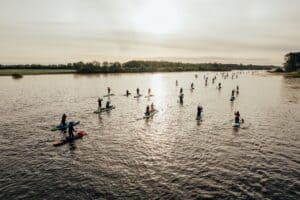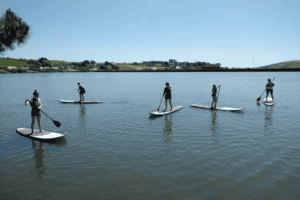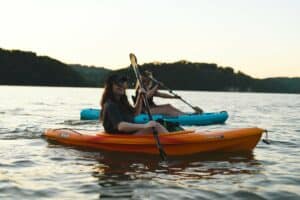Welcome to our beginner’s guide to stand-up paddleboarding (SUP)! If you’ve ever been curious about how to SUP, this is the perfect place to start. Stand-up paddleboarding is a fantastic watersport that offers both relaxation and adventure. Whether you’re gliding across calm waters or catching waves, SUP is a versatile activity that is enjoyable for people of all ages and fitness levels.
In this comprehensive SUP guide for beginners, we will cover everything you need to know to get started. From mastering the basics to enhancing your paddleboarding techniques, we have got you covered. So grab your paddle and let’s dive into the world of SUP!
Key Takeaways:
- Stand-up paddleboarding (SUP) is a versatile watersport suitable for all ages and fitness levels.
- Our beginner’s guide will provide a comprehensive introduction to SUP, from the basics to advanced techniques.
- Choosing the right equipment, mastering balance, and learning proper paddling techniques are essential for a successful SUP experience.
- Adapting to different water and weather conditions is crucial to ensure safety while paddleboarding.
- By following our step-by-step instructions, beginners can learn how to SUP like a pro and continue their learning journey.
Embracing the SUP Basics
Stand-up paddleboarding (SUP) is a versatile and exciting water sport that has gained immense popularity in recent years. Whether you’re an adventure enthusiast or simply looking for a fun and relaxing way to spend time on the water, SUP has something to offer for everyone. In this section, we will delve into the fundamentals of SUP, including its history, benefits, and essential techniques and equipment.
History of SUP: SUP can be traced back to ancient cultures from around the world, including Polynesian, African, and South American civilizations. However, it gained mainstream attention in the modern era when surfers in Hawaii began using paddles to navigate and catch waves. Today, SUP has evolved into a standalone activity that can be enjoyed on various water bodies, including lakes, rivers, and oceans.
Benefits of SUP: SUP provides a full-body workout that combines cardiovascular exercise with strength and balance training. Paddleboarding engages your core muscles, arms, and legs, helping to improve your overall fitness and flexibility. Additionally, spending time on the water promotes relaxation and reduces stress, offering a calming escape from everyday life.
Basic Techniques: The key to getting started with SUP is mastering the basic techniques. Here are some beginner paddleboarding tips to help you get started:
- Stand with your feet shoulder-width apart and slightly bent knees for optimal stability.
- Grip the paddle with one hand on the handle and the other hand on the shaft, ensuring a comfortable and firm hold.
- Rotate your torso and extend your arms as you paddle, using the blade of the paddle to propel yourself forward.
- Maintain a relaxed posture and avoid tensing your muscles, allowing for a more fluid and efficient paddling motion.
- Practice balancing on your SUP board by shifting your weight and adjusting your stance as needed.
By embracing the SUP basics and honing your skills, you’ll be well on your way to becoming a confident and proficient paddleboarder. In the next section, we’ll dive deeper into choosing the right equipment for your SUP adventures.
Choosing the Right Equipment for SUP
When it comes to stand-up paddleboarding (SUP), having the right equipment can make all the difference in your experience on the water. In this section, we will guide you through selecting the perfect SUP equipment, including boards, paddles, and essential accessories.
Different Types of SUP Boards
Before embarking on your SUP journey, it’s important to understand the different types of SUP boards available. Each type is designed for specific purposes and conditions, so choosing the right one for your needs is crucial.
Here are some common types of SUP boards:
- All-Around SUP Boards: These versatile boards are suitable for beginners and can be used in various water conditions.
- Touring SUP Boards: Designed for long-distance paddling, touring boards offer better stability and tracking.
- Inflatable SUP Boards: Known for their portability and easy storage, inflatable boards are convenient for traveling and beginner-friendly.
- Racing SUP Boards: If you’re looking for speed and agility, racing boards are designed for competitive paddlers.
- Surfing SUP Boards: Perfect for riders who want to catch waves, surfing boards have specific shapes and sizes for maneuverability.
Considering factors such as your skill level, preferred paddling environment, and intended use of the board will help you narrow down the options and find the perfect SUP board.
Finding Your Perfect Paddle
The paddle is the most essential tool for propelling yourself on a SUP board. When choosing a paddle, there are a few factors to consider:
- Paddle Length: The length of your paddle should be proportionate to your height and the type of paddling you’ll be doing.
- Paddle Material: Paddles come in various materials, such as aluminum, fiberglass, and carbon fiber, each offering different levels of durability and performance.
- Paddle Blade Shape: The shape of the paddle blade affects your stroke efficiency. Narrower blades are ideal for long-distance paddling, while wider blades provide more power for surfing or quick acceleration.
- Paddle Grip: Look for a comfortable grip that allows for a secure hold and reduces fatigue during extended paddling sessions.
By considering these factors and trying out different paddles, you’ll be able to find the paddle that suits your preferences and enhances your paddling experience.
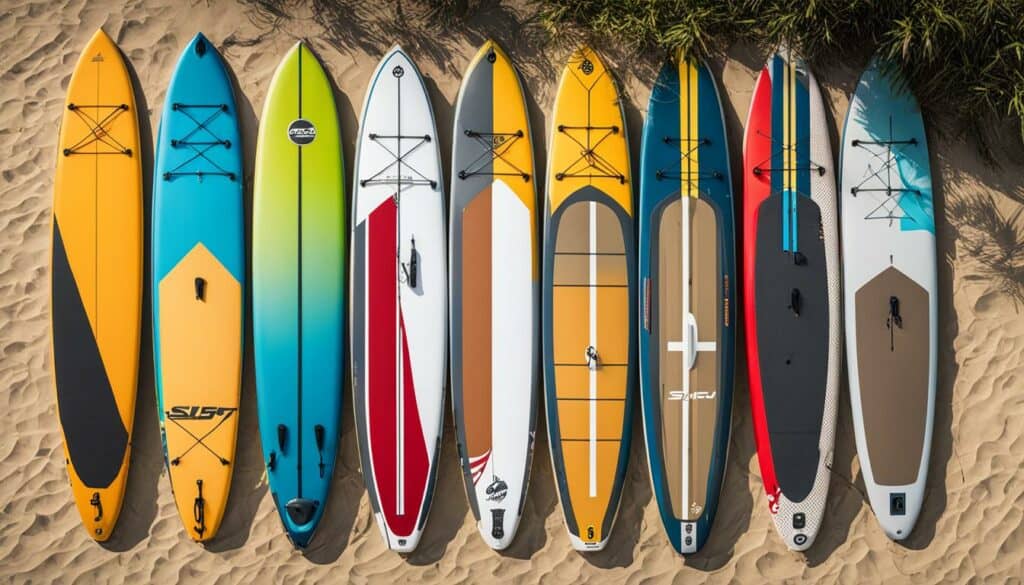
Essential Accessories: Leashes and PFDs
While selecting the right board and paddle is important, it’s equally crucial to invest in essential accessories that ensure your safety and enhance your overall SUP experience.
Two essential accessories that every SUP enthusiast should have are:
- Leashes: A leash attaches you to your board, preventing it from drifting away in case of a fall or strong currents. Choose a leash that is appropriate for your board size and the type of paddling you’ll be doing.
- Personal Flotation Devices (PFDs): Although not always required by law, wearing a PFD, such as a life jacket, is highly recommended for your safety, especially in open waters or when paddling in challenging conditions.
Investing in quality leashes and PFDs will give you peace of mind knowing that you’re prepared for any unexpected situations on the water.
Now that you understand the importance of selecting the right SUP equipment, it’s time to move on to the core principles of paddleboarding. In the next section, we will dive deeper into the techniques and posture necessary to propel yourself efficiently on a SUP board.
The Core Principles of Paddle Boarding
When it comes to mastering the art of paddleboarding, understanding the core principles is crucial. By focusing on proper posture and technique, you can enhance your sup experience, improve your paddling efficiency, and prevent injury.
Let’s dive deeper into the paddleboarding principles:
- Sup Techniques: Mastering the different sup techniques will significantly impact your performance on the water. Whether it’s the forward stroke, sweep stroke, or draw stroke, each technique has a specific purpose and can help you maneuver your board with precision and control.
- Sup Posture: Maintaining the correct posture is the key to balance and stability while paddleboarding. Stand tall with a straight back, engage your core, and distribute your weight evenly on the board. This proper alignment not only prevents muscular strain but also allows you to generate more power with each stroke.
- Biomechanics of Paddling: Understanding the biomechanics of paddling is essential for efficient movement on the water. By engaging your larger muscles, such as your core, back, and legs, and using your arms and shoulders more for stability, you can reduce fatigue and maximize your paddling efficiency.
With these core principles in mind, you’re on your way to becoming a paddleboarding pro. Practice regularly, experiment with different techniques, and always focus on maintaining proper posture and form. Soon enough, you’ll be gliding through the water with confidence and grace.
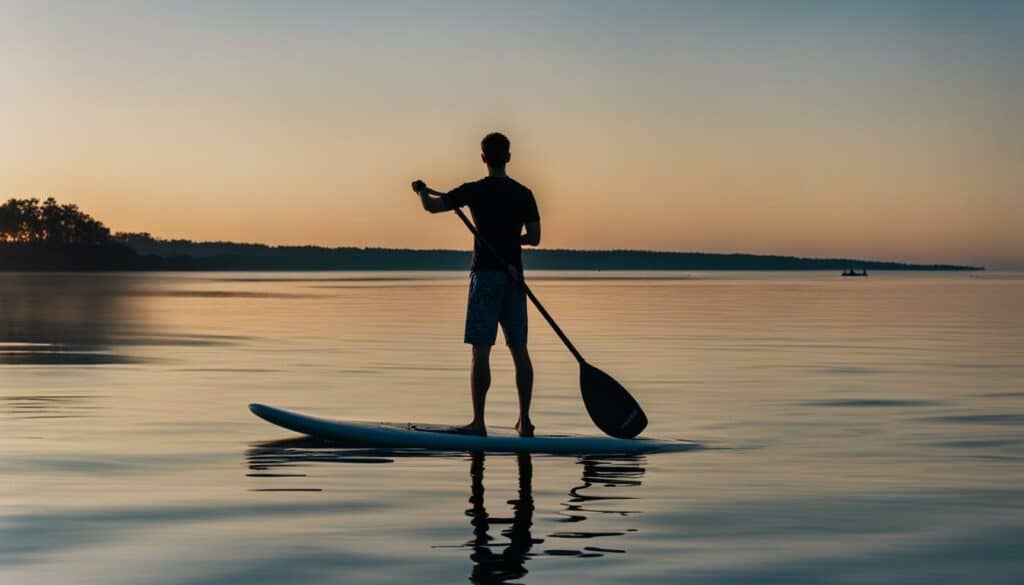
Mastering the Art of Balance on a SUP
Developing balance skills is crucial for a successful stand-up paddleboarding (SUP) experience. Maintaining a stable stance and smoothly transitioning from kneeling to standing are key factors in achieving balance on a SUP.
Proper Stance for Stability
When paddling on a SUP, having the correct stance is essential to maintain stability. Here are some tips to help you find the proper stance:
- Stand with your feet shoulder-width apart, parallel to the stringer (centerline) of the board.
- Distribute your weight evenly between both feet.
- Keep your knees slightly bent to absorb any movements and maintain balance.
- Engage your core muscles to enhance stability.
By following these tips and practicing your stance, you’ll be able to maintain balance on the water and feel more confident on your SUP.
Tips for Smooth Transition from Kneeling to Standing
The transition from kneeling to standing can be challenging for beginners. However, with a few techniques, you can make it a smooth and effortless process:
- Start by kneeling on the board with your hands on the board’s sides.
- Place one foot flat on the board between your hands.
- Plant your foot firmly and engage your core muscles.
- Using your leg strength, slowly rise to a standing position while keeping your balance centered.
Remember to take it slow and focus on finding your balance during the transition. With practice, you’ll become more comfortable and proficient at moving from kneeling to standing on your SUP.
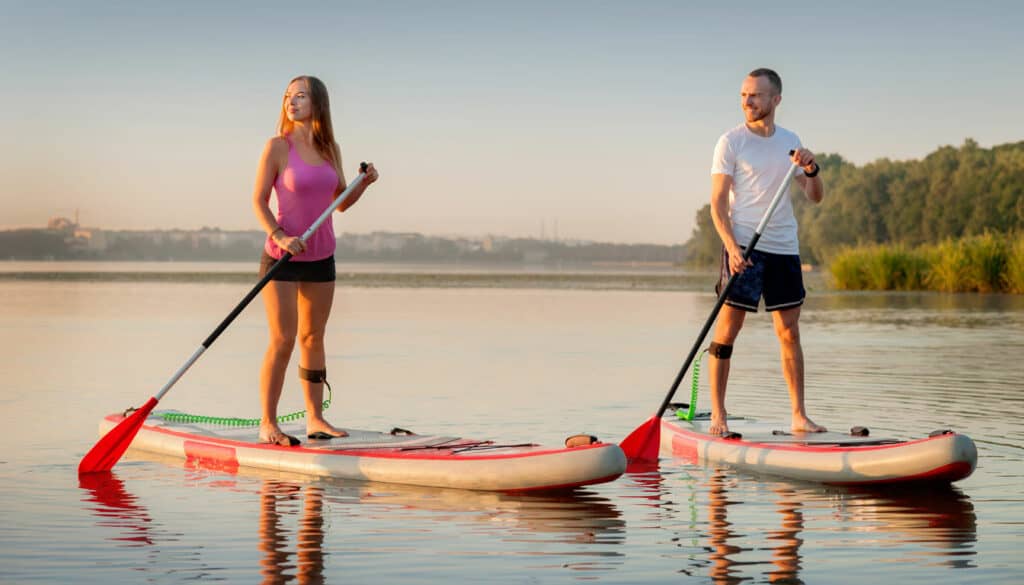
| Common Mistakes | Tips for Success |
|---|---|
| Leaning too far forward or backward | Maintain an upright posture and distribute your weight evenly. |
| Relying solely on arm strength | Engage your core and leg muscles to maintain balance and conserve energy. |
| Not keeping your eyes on the horizon | Focus on a fixed point in the distance to help maintain stability. |
| Standing too quickly | Take your time and rise to a standing position gradually. |
Enhancing Paddling Techniques for Efficiency
Once you’ve mastered the basics of SUP, it’s time to take your paddling skills to the next level. In this section, we will explore advanced sup paddling techniques, provide valuable tips to enhance your performance and efficiency on the water, and delve into different paddle strokes to expand your repertoire.
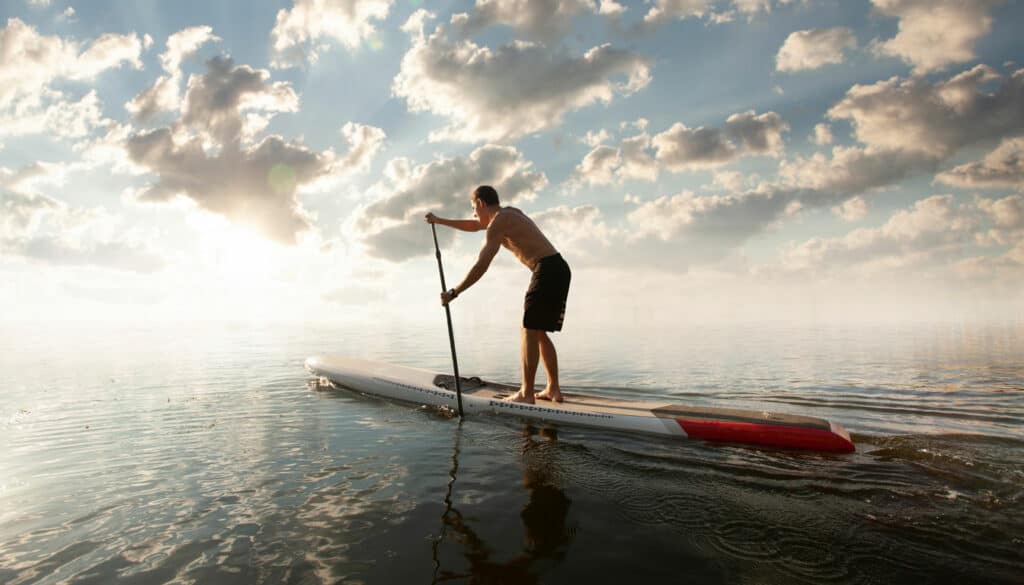
1. Powerful Paddle Strokes: To increase your speed and propulsion, focus on perfecting your paddle strokes. The two primary strokes you should master are the forward stroke and the reverse stroke. The forward stroke involves inserting the paddle into the water with the blade angled towards the tail of the board, pulling it back along the side of the board, and exiting near your feet. The reverse stroke is performed by inserting the paddle near your feet, pulling it forward along the side of the board, and exiting at the nose.
2. Efficient Turning Techniques: Maneuvering your SUP effectively is crucial, especially when navigating tight spaces or changing directions quickly. Two commonly used turning techniques are the sweep stroke and the sidestroke. The sweep stroke involves sweeping the paddle in a wide arc away from the board, allowing the blade to act as a rudder, turning the board in the desired direction. The sidestroke, on the other hand, involves taking short, quick strokes on one side of the board to pivot it in the desired direction.
3. Mastering Different Water Conditions: As you progress in your SUP journey, you’ll encounter various water conditions that require different strategies. In choppy or rough waters, it’s essential to maintain stability and adapt your paddle strokes to accommodate the waves. Experiment with shorter and quicker strokes to maintain control and prevent the waves from throwing you off balance. In calm waters, you can focus on refining your technique and efficiency, using longer and more powerful strokes for maximum speed.
By incorporating these advanced sup tips and paddle strokes into your practice sessions, you’ll enhance your overall performance, enjoy a smoother and more efficient paddling experience, and gain confidence in tackling different water conditions. Remember, practice makes perfect, so continue to refine and hone your skills as you embark on your SUP adventures.
Adapting to Various Water Conditions
Paddling in Calm vs. Rough Waters
When it comes to stand-up paddleboarding (SUP), understanding how to adapt to different water conditions is crucial for both safety and enjoyment. Paddling in calm waters provides a serene and tranquil experience, allowing you to focus on the beauty of your surroundings. It’s the perfect opportunity to practice your balance and paddle strokes without the distraction of strong currents or waves.
On the other hand, paddling in rough waters can be thrilling and challenging. It requires a different set of skills and techniques to navigate through waves and turbulent conditions. Building your confidence and experience in rough waters will open up new possibilities for exploration and adventure.
Whether you prefer calm or rough waters, it’s important to assess your skill level and evaluate the conditions before heading out. Beginners should start with calmer waters and gradually progress to more challenging conditions as they gain experience and confidence.
Understanding the Impact of Weather
Weather conditions play a significant role in paddleboarding, and understanding their impact is essential for a safe and enjoyable experience. Before embarking on your SUP adventure, it’s crucial to check the weather forecast and take note of the following:
- Wind: Wind speed and direction can greatly affect your paddleboarding experience. Paddling against strong headwinds can be physically demanding, while crosswinds can push you off course. It’s advisable to paddle into the wind first, so it becomes easier to return with the wind at your back.
- Temperature: Dress appropriately for the weather to ensure comfort and prevent hypothermia. In colder conditions, consider wearing a wetsuit or drysuit and layers that can be easily adjusted.
- Tides and Currents: Research the tidal patterns and current flow in your chosen paddling area. Paddling against strong currents can be challenging and may require advanced skills.
- Visibility: Foggy or low-visibility conditions can make it difficult to navigate and locate hazards. Make sure you have proper visibility and consider using a brightly colored personal flotation device to enhance your visibility to other watercraft.
By paying careful attention to water and weather conditions, you can make informed decisions to ensure your safety and maximize your enjoyment while paddleboarding. Remember, always prioritize your safety and adjust your plans accordingly based on the prevailing conditions.
How to SUP: The Complete Beginner’s Breakdown
Now that you have familiarized yourself with the basics of stand-up paddleboarding, it’s time to delve deeper into the step-by-step process of SUP. This comprehensive guide will take you through every stage, from preparing and launching the board to perfecting your paddling technique and prioritizing safety.
1. Preparing for Your SUP Adventure
Before you hit the water, ensure you have the necessary equipment. Double-check that your board, paddle, leash, and personal flotation device (PFD) are all in good working condition. Make sure you are dressed appropriately for the weather and have sunscreen and water to stay hydrated during your outing.
2. Choosing the Right Launch Spot
Select a suitable location for launching your SUP board. Look for calm waters and minimal boat traffic, especially if you’re a beginner. Avoid areas with strong currents, large waves, or submerged obstacles that may pose a safety risk.
3. Board Handling and Entering the Water
Hold your board on its side with one hand on the rail and the other on the center handle. Walk into the water until it reaches your knees, then carefully place your paddle across the board’s deck. With one hand on the paddle, use the other hand to push off into deeper water.
4. Finding Your Balance and Getting to Your Feet
Start by kneeling on the board, positioning yourself in the middle. Once you feel balanced, place your hands on the board in front of your knees and slowly stand up, maintaining a stable and relaxed stance. Keep your feet hip-width apart and centered between the board’s edges.
5. Mastering the Paddle Stroke Techniques
Hold your paddle with one hand on the T-grip and the other hand on the shaft. Dip the blade into the water at the front of the board and pull it through the water, using your core and arm muscles to generate power. Alternate your strokes on each side, keeping your body upright and using your legs for stability.
6. Steering and Turning on Your SUP
To steer your board, use a sweeping stroke on the side opposite the direction you want to turn. For sharper turns, drag the paddle towards the tail of the board while using your back foot to pivot. Practice different turning techniques until you feel confident and in control.
7. Putting Safety First
Always prioritize safety when SUPing. Wear your PFD at all times, especially in areas with strong currents or open water. Familiarize yourself with the local rules and regulations, and respect other water users. Be mindful of weather conditions and avoid paddling in strong winds, thunderstorms, or rough waters.
By following this step-by-step breakdown, you’ll be well on your way to enjoying the thrilling world of stand-up paddleboarding. Remember to practice regularly, seek further instruction if needed, and most importantly, have fun!
Conclusion
After diving into the world of stand-up paddleboarding (SUP), you’ve gained a solid foundation of knowledge and skills to embark on this exciting water sport. Throughout this guide, we’ve covered the basics of SUP, explored different types of boards and paddles, and delved into essential techniques and principles to improve your paddleboarding experience.
Remember the importance of choosing the right equipment for your needs. Whether you prefer a leisurely ride on calm waters or crave the thrill of riding waves, selecting the appropriate board and paddle can enhance your performance and enjoyment on the water. And don’t forget to equip yourself with accessories like leashes and personal flotation devices (PFDs) to ensure your safety.
Finding balance on a SUP is key to a stable and confident ride. By mastering your stance and transitioning smoothly from kneeling to standing, you’ll feel more comfortable and in control. Additionally, honing your paddling techniques will help you navigate different water conditions with ease, allowing you to glide gracefully through calm waters or tackle rougher seas.
As you continue on your SUP journey, be mindful of the impact of weather conditions on your adventures. Paddling in calm versus rough waters requires different approaches, and understanding how weather patterns can affect the water’s behavior is crucial for your safety and enjoyment.
Finally, congratulations on completing the SUP guide! With your newfound knowledge and skills, you are ready to explore the world of stand-up paddleboarding and create unforgettable experiences on the water. So grab your board, paddle into new horizons, and let the adventure begin!
FAQ
What is SUP?
SUP stands for Stand-Up Paddleboarding. It is a water sport where individuals stand on a large board and use a paddle to propel themselves forward.
What are the benefits of SUP?
SUP offers numerous benefits, including improved cardiovascular fitness, increased core strength, enhanced balance, reduced stress levels, and a chance to enjoy nature and explore waterways.
How do you pronounce SUP?
SUP is pronounced as “suhp,” with a short “uh” sound.
What does SUP mean?
SUP is an acronym that stands for Stand-Up Paddleboarding.
What are some easy and healthy SUP recipes?
While SUP usually refers to Stand-Up Paddleboarding, if you’re looking for easy and healthy supper (or dinner) recipes, there are plenty of options. Some ideas include grilled salmon with roasted vegetables, quinoa and vegetable stir-fry, and avocado chicken salad.
How can beginners choose the right SUP board?
When selecting a SUP board, beginners should consider their skill level, intended use (such as cruising, surfing, or yoga), weight, and storage space. It’s important to choose a board with adequate stability and buoyancy for a comfortable experience.
What factors should I consider when choosing a paddle for SUP?
When selecting a paddle for SUP, consider the material (aluminum, fiberglass, or carbon), length (based on your height and paddling style), blade shape, and weight. It’s recommended to try different paddle options to find the one that feels comfortable and efficient for you.
Why are accessories like leashes and PFDs important for SUP?
Accessories like leashes and Personal Flotation Devices (PFDs) are crucial for SUP safety. Leashes help keep you attached to the board in case of falls, while PFDs provide buoyancy and can be lifesaving in emergencies.
What is the proper posture and technique for paddleboarding?
Proper posture and technique for paddleboarding involve standing with feet hip-width apart and parallel to the board, bending the knees slightly, engaging the core, and maintaining a relaxed grip on the paddle. The technique includes using the core and upper body to generate power during each stroke.
How can I improve my balance on a SUP?
To enhance balance on a SUP, focus on maintaining a stable stance with your feet hip-width apart, shifting your weight slightly forward, and keeping your gaze on the horizon. Practicing transitions from kneeling to standing can also help improve balance over time.
What are some advanced paddling techniques for SUP?
Advanced paddling techniques include various paddle strokes such as the forward stroke, reverse stroke, sweep stroke, and draw stroke. These techniques allow for better maneuverability and efficiency in different water conditions.
How does water and weather impact paddleboarding?
Water conditions, such as calm or rough waters, can affect stability and require adjustments in technique. Weather conditions like wind and currents should also be considered for safety and planning purposes when paddleboarding.
Can you provide a step-by-step breakdown of the SUP process for beginners?
Certainly! A complete beginner’s breakdown of the SUP process includes preparing the board and equipment, launching the board from the shore or dock, standing up on the board, using proper paddling techniques, and following safety guidelines while enjoying the experience on the water.

